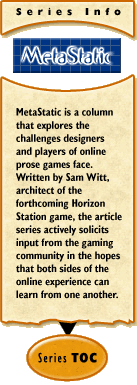 The External Community The External Community
by Sam Witt
January 31, 2001
When a designer looks at the community he's constructing for his game, it's important not to overlook the larger picture, the community beyond the confines of the game. It's all well and good to have a thriving game economy and a complex supply-and-demand system that binds all the various types of characters together in a synchronized dance of happiness, but that's only half the picture.
For a game to succeed, for it to really grow and remain vibrant, the community has to expand beyond its borders, into what I call the external community. Today, I'm going to talk a little about what I feel are some of the more important 'support elements' for an online game like the ones we're building here.
- Message Boards. Possibly the single most important piece of the exterior community are the official message boards. The boards let designers get a quick look at how the players are reacting to the game, and provide a threat-free environment to discuss the game and its development. In my opinion, designers should spend some time every day at least reading the boards. It's good for everyone.
- The Newspaper. It puzzles me that most games do not have much in the way of an official web presence for reporting on major events within the game. It is a good thing to encourage players who do this (see below), but it is a big benefit to the designers if they do a little reporting of their own to spread the word. If some official event occurs in the game, then it should be on the official site, along with message board links for player commentary. The 'newspaper' for your game should be the source for official information on the current game environment.
- Reward and Publicize Player-Run Sites. Players love games, and they love talking about games. An enthusiastic few even enjoy building websites to talk about the games they love. These sites are often a treasure trove of game information, meticulous details that even the game's designers may not always remember. It is crucial that these sites be brought into the fold of the external community. Link to them from the main game site, have a monthly contest with the winning site given a banner link on the game's main page. Where the official site is the definitive source for all canonical game information and events, the players do an admirable job covering virtually everything that happens in the game, often with a nice personal slant.
- Break the Ice. Surprisingly, a great many of the people who play our games are shy. Help them make friends with other players through in-game social events. Set up a registry that allows players to list their playing times, contact information, and brief character biographies. Finding others to enjoy the game with can be a high barrier to enjoying the game for those who are not outgoing, and helping players over this hurdle can turn a good game into a great one.
- Give Something Back. The external community spreads the word to the larger gaming world, and beyond. A game can become popular more rapidly when the designers work to reward those who proselytize on their behalf – anything from a brief in-game mention to a link on the main page to a special recognition ceremony at player gatherings. The important thing is that you, as a designer, make your appreciation of the external community well known.
So those are my free bits of advice for this week. Next week, I turn an eye back toward the nuts and bolts of game design with a look at the random factor.

|



